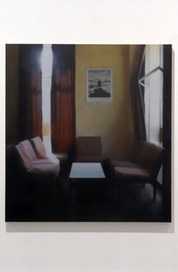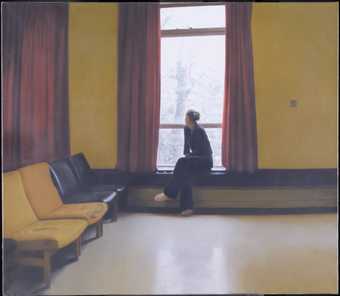Paul Winstanley paints from photographs, generally ones he has taken himself. It is during the process of transcription from two dimensional photographic surface into paint that the final picture emerges and he often departs from the photographic record to emphasise a detail or mood.
Winstanley's raw material is a particular brand of semi-public space, the ubiquitous waiting rooms, lobbies, underpasses and hostel interiors of the 1960s architect and town planner. From these now shabby relics of corporate utopia, the artist has rescued a series of spaces, which, while lacking a human presence, contain in his words, 'the potential for human drama'; a student lounge, sunlight filtered through thin orange-red curtains; an anonymous mini-cab office at night, Hopper-like and empty under the glare of reflected street lighting; a lecture room with its rows of Rexene covered chairs; a television room where the central focus is provided by a blank screen. In the artist's hands, these mundane images acquire a particular resonance. The immaculate, apparently weightless surfaces, rendered with photographic precision, seem to act as protective layers, screening the viewer from a heavier and more sombre reality. For Winstanley, these urban and somehow elegiac images of empty rooms are as much a part of our cultural and emotional heritage as the modernist architecture of earlier periods. He sees the paintings as archetypes, as keys to both personal and collective memory. In these waiting rooms and lounges we are invited to see the ultimate or distilled expression of a broader common experience of the contemporary world.
In one of these works a sepia reproduction of Caspar David Friedrich's painting, Traveller looking over a Sea of Fog c.1818, has found its way into a student lounge. Placed centrally, it seems to act as a window onto another reality. Friedrich's painting, in which a figure is turned away from the viewer to survey fog shrouded mountain peaks, is commonly held to symbolise man's triumph over death; here it suggests an escape route from banal reality. Winstanley allows his audience some leeway for personal reverie and his allusion to Friedrich's sublime vision in the context of post war social engineering suggests another perhaps more fanciful connection with the earlier artist.
Not many kilometres from the white Baltic cliffs made famous by Friedrich, there exists another reality, the conspicuously unsignposted, now half ruined remains of a huge ribbon development of 1930s holiday flats, built to house Nazi holiday makers. What in other circumstances might simply be regarded as the shabby leftovers of another failed modern dream has inevitably acquired a more chilling significance. Here heaven on earth has become a sinister slum, an annexe of history. The architecture that Winstanley invites us to become part of, though no less improbable, is altogether more provisional. As with all successful art, image and reality have fused in his paintings. His interiors are full of potential. Things can change and it is up to the viewer to complete the picture.
Text written by Catherine Kinley
Biography
Born 1954. Lives and works in London. 1972-73 Lanchester Polytechnic. 1973-76 Cardiff College of Art. 1976-78 Slade School of Art.


